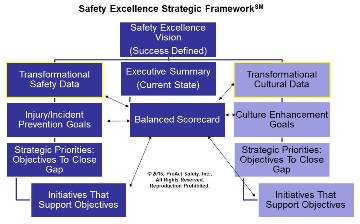Visualizing a Comprehensive Safety Excellence Strategic Framework
Most organizations, both at the corporate and local site level can only effectively manage and execute against four to five major priorities per year.
After reviewing countless corporate and site-level safety excellence strategies, it is clear many are missing key elements and important decisions are overlooked. How comprehensive is your three-to-five-year safety strategy?
Strategy is a framework of choices, tradeoffs, and small bets an organization makes to determine how to capture and deliver value and win. Driven first by hypothesis, then validated by data, there are two sides to this framework: injury/incident prevention and culture. A comprehensive strategic framework will include the following elements in a flow-down model, as outlined in the figure below.
Safety Excellence Vision (Success Defined). It must be defined what safety excellence would look like and what the new reality would be, more than the results and management systems. What beliefs, knowledge, behaviors, experiences, and stories would be common? Successful clients take this further and operationalize this for each of the working groups, because everyone should know what safety excellence would look like in their work. It must be clear to all: When we have great results, this would be why. This will act as a qualifier in which other decisions will be measured against.
Transformational Safety Data. A comprehensive analysis on injuries and incidents must be performed to drive the strategic choices that follow. With the ever-increasing need to become more effective and efficient, identifying where to focus efforts reactively and proactively has become one of the most important decisions an operation can make. ProAct Safety has identified 28 commonly found variables (i.e., time of day, day of week, tenure, influences, weather, task, location, shift, etc.) that have provided key insight into organizational risk and what to focus on for maximum improvement. A prevention trend analysis also should be performed to determine whether the events are mostly preventable by improving conditions (hazards, risks), technology, or human factors and which ones, if addressed, would provide the greatest return.
 Transformational Cultural Data. Data should be collected to prove or disprove the desired state choices made in the Safety Excellence Vision. This data will come from questionnaires, perception surveys, safety climate and safety chemistry surveys, day-in-the-life-of surveys, focus group and individual interviews, audits and observations, and subject matter expert interpretation. Just as data are necessary to drive injury- and incident-prevention goals and initiatives, data about the culture should be made available. Never let opinions drive the full execution of your strategy at the corporate or site level.
Transformational Cultural Data. Data should be collected to prove or disprove the desired state choices made in the Safety Excellence Vision. This data will come from questionnaires, perception surveys, safety climate and safety chemistry surveys, day-in-the-life-of surveys, focus group and individual interviews, audits and observations, and subject matter expert interpretation. Just as data are necessary to drive injury- and incident-prevention goals and initiatives, data about the culture should be made available. Never let opinions drive the full execution of your strategy at the corporate or site level.
Executive Summary (Current State). After trends are visible on both sides of the strategy, this is a data-driven outline of where the organization currently is and where the most important gaps exist between the current focus of the strategy and safety management system (including programs and processes and injury results), as well as an understanding of where the culture currently is compared to what would be desired. Key findings are placed here so a compelling case for improvement can be made and inform subsequent safety strategy decisions.
Injury/Incident Prevention and Culture Enhancement Goals. After understanding where the organization needs to go in safety performance and culture, then determining the current reality and needs, clear goals are established on both sides of the strategic framework (injury/incident prevention and culture enhancement). These goals are usually stated at a higher level and not as descriptive as the priorities and initiatives that support them.
Strategic Priorities: Objectives to Close Gaps. Most organizations, both at the corporate and local site level can only effectively manage and execute against four to five major priorities per year. Typical client engagements result in a longer list of vital priorities that are then spread out over three to five years when the reality of budget, resources, time, and competitive priorities sets in.
Initiatives That Support Objectives. What specifically will we do, not do, or stop doing that will best support the priorities and goals and help us get closer to our desired state? Here it should become obvious why the desired state is determined first. If we cannot prove the actions we will take will directly get us closer to both what we are required to do and where we are trying to go, we may want to reassess the initiative with the question: how will this add value?
Balanced Scorecard. To measure the efficacy of the strategy and to continue to drive for continuous improvement, a balance of measurements must be in place that include, but are not limited to: lagging indicators, safety management system implementation and overall effectiveness, strategy execution, climate, chemistry and culture, and how well the organization is learning.
There should exist a strategic framework at the corporate level so there is alignment with the business strategy and to set cascading or universal goals and priorities, yet allow some flexibility and autonomy at the site level to create their own, unique to their needs for improving both performance and culture. Does your strategy have information and decisions around these important elements? If not, it's time to reassess.
This article originally appeared in the February 2017 issue of Occupational Health & Safety.